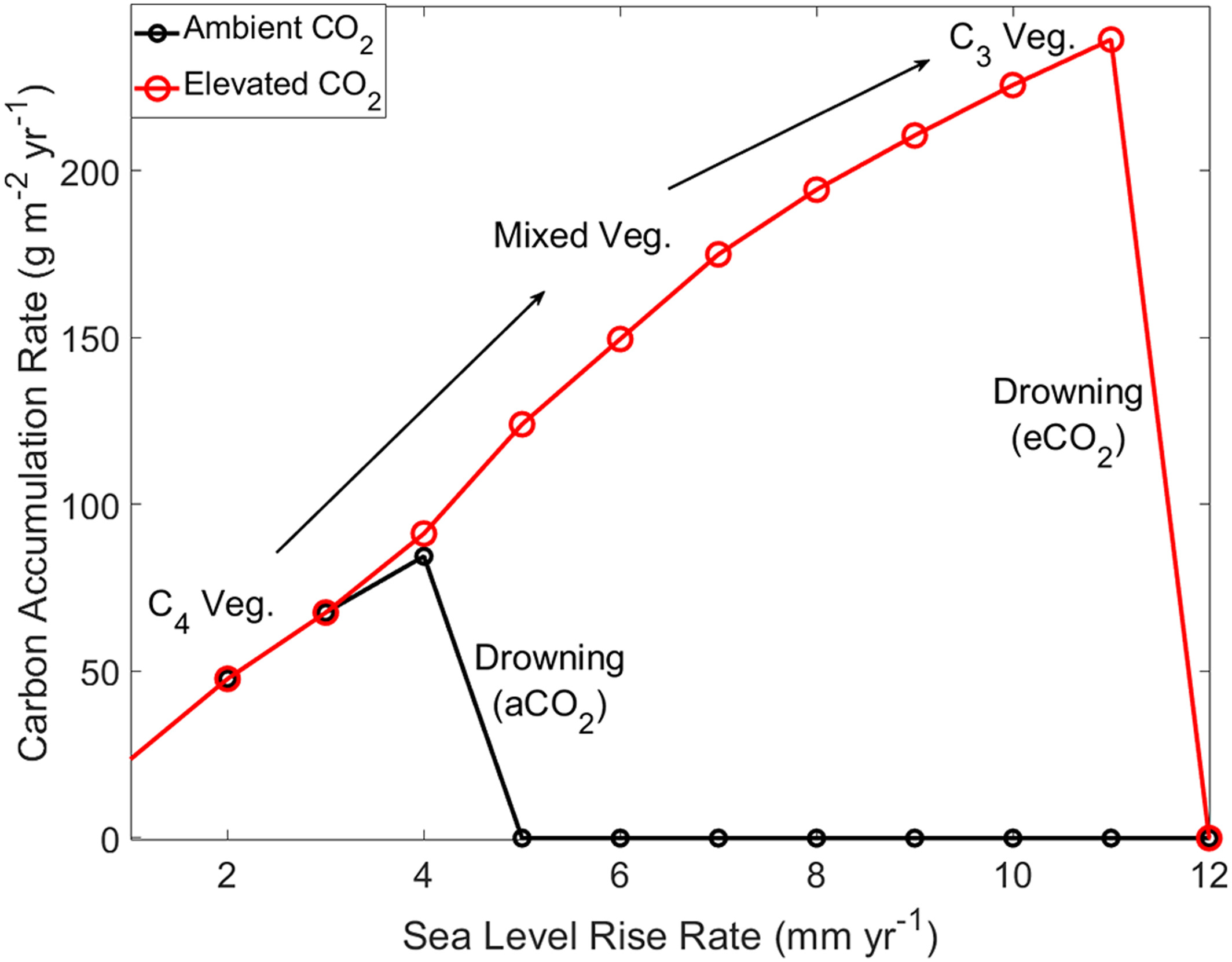March 15, 2021
How Does Elevated CO2 Influence Coastal Carbon Cycling?
A new numerical model shows that elevated CO2 increases the resilience of coastal marshes in the face of sea level rise and enhances their ability to sequester carbon.

Modeled carbon accumulation rates in tidal marsh soils under ambient (black) and elevated CO2 (red). Soil carbon accumulation rates increase with sea level rise in both cases, but enhanced plant productivity under elevated CO2 allows marshes to survive faster rates of sea level rise and accumulate more soil carbon.
[Reprinted with permission from Rietl, A.J., et al. “Vegetation Type and Soil Priming Drive Marsh Carbon Accumulation under Interacting Facets of Global Change.” Geophysical Research Letters 48 (8), e2020GL09205 (2021) [DOI:10.1029/2020GL092051] © 2022 John Wiley & Sons Ltd.]
The Science
SMARTX is a whole-ecosystem warming experiment that was established in a Chesapeake Bay tidal marsh in 2016 to understand how interacting facets of climate change influence carbon accumulation. Researchers modeled plant inputs and organic matter decomposition using data from the SMARTX project and found that sea level rise and elevated carbon dioxide (CO2) interact to strongly enhance soil volume and carbon accumulation. This effect was driven primarily by the tendency for sea level rise to cause a vegetation shift toward a more flood tolerant plant community that in turn is more responsive to elevated CO2.
The Impact
In contrast to terrestrial ecosystems in which climate change is thought to enhance carbon emissions, these findings suggest that coastal carbon storage may increase with climate change. This implies stabilizing feedback where elevated CO2, warmer temperatures, and faster rates of sea level rise could potentially enhance carbon sequestration in marshes and help mitigate the impacts of CO2 emissions.
Summary
Coastal marshes play a disproportionate role in regulating Earth’s climate because they sequester carbon at rates that are an order of magnitude higher than terrestrial environments. However, the response of these carbon pools to interacting facets of climate change is not well understood, and there is concern that carbon stored in marshes will be vulnerable to future sea level rise. This study uses data from the SMARTX experiment to develop a new computer model that simulates how marshes and their carbon pools will change in response to accelerating rates of sea level rise and enhanced CO2 in the atmosphere. Researchers find that sea level rise leads to a change in vegetation type that is more responsive to elevated CO2. This vegetation shift led to both increased productivity and decomposition of soil organic matter in the model. However, the net impact was that elevated CO2 allowed marshes to survive faster rates of sea level rise and accumulate more carbon in their soils.
Principal Investigator
Matthew Kirwan
Virginia Institute of Marine Science
kirwan@vims.edu
Program Manager
Daniel Stover
U.S. Department of Energy, Biological and Environmental Research (SC-33)
Environmental System Science
daniel.stover@science.doe.gov
Funding
This work was supported by the Office of Biological and Environmental Research (DE-SC0014413 and DE-SC0019110) within the U.S. Department of Energy Office of Science.
References
Rietl, A.J., et al. "Vegetation Type and Soil Priming Drive Marsh Carbon Accumulation under Interacting Facets of Global Change." Geophysical Research Letters 48 (8), e2020GL09205 (2021). https://doi.org/10.1029/2020GL092051.

